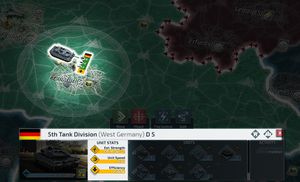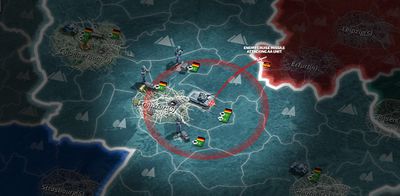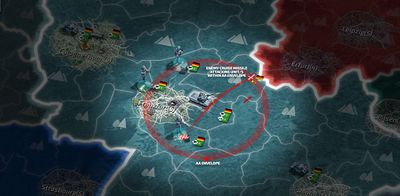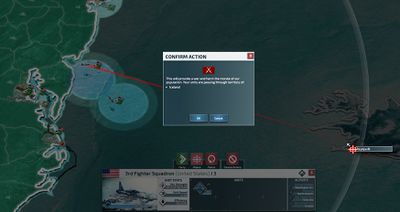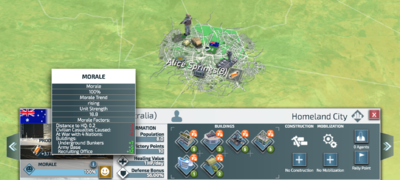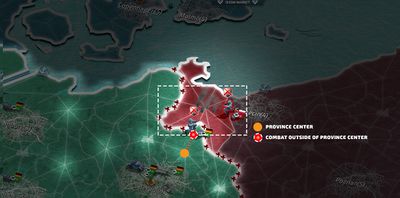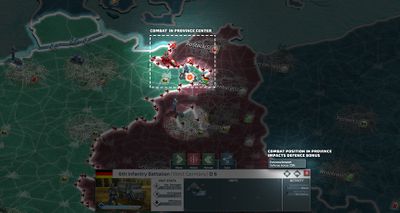Difference between revisions of "Combat"
From Conflict of Nations Wiki
| Line 69: | Line 69: | ||
<h3>Unit Healing</h3> | <h3>Unit Healing</h3> | ||
<div> | <div> | ||
| − | Ground and Air [[Units|units]] can heal in cities [[Provinces#Cities|cities]] which you control, as well as cities which you have access to, either through a coalition, through Shared Intelligence, or even through Right of Way. Note that units are not required to be at the centre of that city to heal, since being within the province borders is sufficient for recovery to take place. Also, air units | + | Ground and Air [[Units|units]] can heal in cities [[Provinces#Cities|cities]] which you control, as well as cities which you have access to, either through a coalition, through Shared Intelligence, or even through Right of Way. Note that units are not required to be at the centre of that city to heal, since being within the province borders is sufficient for recovery to take place. Also, air units will heal at the same rate as ships if they are on a carrier which is on coastal waters. (2 HP / Day) |
<br><br> | <br><br> | ||
The base healing for cities is +1HP per day and increased according to the level of the Military Hospital in that city: | The base healing for cities is +1HP per day and increased according to the level of the Military Hospital in that city: | ||
| Line 87: | Line 87: | ||
</ul> | </ul> | ||
<br> | <br> | ||
| − | Naval units recover HP in [[Provinces#Terrain_Types| coastal waters]] at a rate of +2HP per day. Note that naval units need to be out of combat in order for HP recovery to take place | + | Naval units recover HP in [[Provinces#Terrain_Types| coastal waters]] at a rate of +2HP per day. Note that naval units need to be out of combat in order for HP recovery to take place. |
</div> | </div> | ||
Revision as of 03:06, 28 January 2019
Contents
Combat at a Glance
Combat aims to establish total dominance over an opposing force. To succeed, you must hone your tactical awareness. As commander of an entire nation, you need a deep understanding of the intricate details of modern war. Study the mechanics of close-combat attack and defense, as well as how combat might play out in different scenarios. Victory goes to the prepared.
- Diligence - Anticipate diplomatic interference and counter attacks, as well as growing insurgent areas.
- Effective strategy - Think ahead and don't waste resources. Every decision counts, especially when you are investing real-time.
- Resources - Keep an eye on your resource production. Consider provinces and cities that you require for further Arms Industries construction. If new territory is hard to acquire on your own, ally with someone.
- Diplomacy - Diplomatic relations will make or break the game and must not be under-valued.
Combat In Detail
Army Stacking Penalties
To simulate modern logistics and fire-and-maneuver doctrines, you will notice a strict stacking penalty for units. Expect to see diminishing returns, and even negative modifiers, in combat strength and movement speed as units are added to the army stack.
![]()
![]()
![]()
- If marked yellow, the unit stack suffers from diminishing returns, i.e. every additional unit added to the stack makes it less effective.
- If marked orange, every new unit added to the stack does not contribute additional strength.
- If marked red, every new unit added to the stack weakens its overall strength.
Missile Warfare







Modern battlefields are extremely hostile due to the very high amount of damage concentrated in very small delivery systems, such as Cruise Missiles. In an effort to simulate the use of non-ballistic, tactical missiles on the modern battlefield, CON allows dedicated air, ground, and naval units to fire conventional, chemical, and nuclear cruise missiles at military targets.
Note that only cruise missiles are able to target and track units, while ballistic missiles and ICBMs can only target the centre-points of Provinces.
Terrain Modifiers
Terrain places specific demands on the soldiers and machines in CON. A unit's stats are directly affected by the type of terrain it is currently positioned on. Toggle the Terrain Types overlay from the Settings & Info Panel to aid your planning.
The following unit attributes are affected by terrain. You can view the modifiers for each unit through the Unit Info Panel:
- Attack - A unit will be influenced either positively or negatively by this percentage when in this terrain while on attack.
- Defense - A unit will be influenced either positively or negatively by this percentage when in this terrain while in defensive actions.
- Speed Value - A unit will be modified by this percentage as it travels through the defined environment.
- Hit Points - a unit’s Hit Points will be modified depending upon terrain.
- Field of View - The sight range at which your unit can be visually detected varies by terrain. This is different from radar range, and is shown on the map as the brightest view around your unit
Entrenching
Placing a unit stack on a provincial center-point will provide a defensive entrenchment bonus while it remains there. This is automatic and stops once the unit is ordered to move on. The entrenchment bonus can be increased through the construction of certain buildings.
Unit Healing
Ground and Air units can heal in cities cities which you control, as well as cities which you have access to, either through a coalition, through Shared Intelligence, or even through Right of Way. Note that units are not required to be at the centre of that city to heal, since being within the province borders is sufficient for recovery to take place. Also, air units will heal at the same rate as ships if they are on a carrier which is on coastal waters. (2 HP / Day)
The base healing for cities is +1HP per day and increased according to the level of the Military Hospital in that city:
- A level 1 Military Hospital heals at a rate of +1HP per day
- A level 2 Military Hospital heals at a rate of +2HP per day
- A level 3 Military Hospital heals at a rate of +3HP per day
- A level 4 Military Hospital heals at a rate of +4HP per day
- A level 5 Military Hospital heals at a rate of +5HP per day
The base healing for provinces is +0HP per day and increased according to the level of the Field Hospital in that province:
- A level 1 Field Hospital heals at a rate of +1HP per day
- A level 2 Field Hospital heals at a rate of +2HP per day
- A level 3 Field Hospital heals at a rate of +3HP per day
Naval units recover HP in coastal waters at a rate of +2HP per day. Note that naval units need to be out of combat in order for HP recovery to take place.
Retreating
You can order a unit that is engaged in combat to retreat to the nearest, friendly territory, at the cost of hit points. Only ground and naval units can retreat.
- Retreating units gain significant movement speed.
- Even though retreating units bleed HP, they are incredibly hard to hit by hostile units.
Hardened Bunkers
Bunkers shield your population against weapons of mass destruction. The higher the bunker level, the more of a city's population will survive a serious attack.
- Bunkers can be constructed in cities in order to shield the population from harm.
- The amount of population shielded is twice the level of the bunker. E.g. a level 1 bunker shields a population of 2, a level 2 bunker shields a population of 4, and so on...
- The shielded population takes no damage until the bunker is destroyed.
Crimes Against Humanity
In conflict zones, civilian casualties will often be inevitable. Certain units and weapons inflict more harm on local population than others. Be sure to check the Unit Info Panel to gauge how devastating the effects will be. If your actions indiscriminately cause civilian casualties during your conquest, there can be dire consequences:
- Your own civilian population will be abhorred by your actions, and national morale will begin to suffer.
- Weapons such as chemical warheads and nuclear warheads may be highly effective at destroying soft and hard targets, but decimate local population in the process.
- Your own nation's morale will recover very slowly over time after committing such crimes.
Units sent into enemy cities that are not yet conquered will start decimating the local population. This is considered a war crime and can have severe consequences with the morale of the player’s population – especially if large numbers of civilians suffer from this behavior.
Chemical and Nuclear Warfare
Probably the strongest weapons ever invented, these are the ultimate killers – albeit with a double edge. The resulting loss of life, devastation and contamination wrought by one of these weapons of mass destruction will not go unchecked by other nations and of the perpetrator’s own population. In Conflict of Nations there is the real chance of the world turning into a contaminated wasteland, populated by unhappy survivors. We warned you…
Stealth Units
Stealth units can have both meeting and offensive/defensive engagements, and can infiltrate another nation's territory without triggering war. See the Stealth section for more info.
Anti-Air vs Missiles
When you launch missiles against a target, we distinguish between two cases:
Point Defense
If the stack that your missile is attacking is/contains an anti-air unit, the combat tick is calculated as Point Defense. This means that the anti-air unit will defend itself every time against incoming missiles, i.e. there is no cool-down.
For example:
You fire two missile against an anti-air unit. It does not matter whether you fired your missiles one second or one hour apart, anti-air will defend against them every time.
AA Envelope
If the stack that your missile is attacking is a unit that is standing within anti-air range, but is not part of the same stack, the combat tick is calculated as AA Envelope. This means that the anti-air unit will go on cool-down before it can defend a close-by unit again.
For example:
You quickly fire two missile against an infantry unit that is standing within an anti-air unit's envelope that is standing close by. You fire another missile directly at the anti-air unit as well:
- The first missile, aimed at the infantry unit, is shot down by the anti-air unit.
- The second missile, however, lands a hit on the infantry unit since the anti-air unit's envelope is on cool-down.
- The third missile, directly aimed at the anti-air unit, is shot down since it is calculated as Point Defense.
Acts of War
Declaring War through the Diplomatic Panel
To declare war, click the Diplomacy button and select the target player. Then, from the drop-down menu, change your status from Peace to War. You could even be diplomatic about the process and send a note stating your justifications for doing so, but most commanders won’t be so kind.
Declaring War through Invasion
You declare war by default, when you trespass on the province of a nation with which you do not share a special diplomatic relationship. You will receive a pop-up warning whenever your move order would constitute an act of war.
If you want to move units through another nation's territory, you both must be members of the same coalition, or your diplomatic relation with that country needs to be one of the following:
Changes to Population Morale
When you declare war, it affects your nation as a whole. This war penalty affects all your provinces' morale, which slows down resource production as well as troop mobilization. You receive a penalty for every country you are at war with.
To see your war penalty, select one of your provinces, and click the i button beside the Morale indicator in the province bar. This will also show you what else affects morale in the selected province.
Combat Mechanics
When two armies are engaged, combat rounds are calculated every hour. We differentiate between four possible scenarios:
- Meeting engagements
- Attack/Defense engagements
- Edge cases
- Cases where two armies are in movement
Meeting Engagement
Scenario: Army A attacks army B in the open - where army B is stationed outside of the province's center-point.
First Combat Tick (immediately):
- Army A attacks army B using its offensive stats
- Army B defends against army A using its defensive stats
- Army B counter-attacks army A using its offensive stats
- Army A defends against army B using its defensive stats
Second Combat Tick (after 1 hour has passed):
- Army A attacks Army B using its offensive stats
- Army B defends against Army A using its defensive stats
- Army B counter-attacks Army A using its offensive stats
- Army A defends against Army B using its defensive stats
- and so on...
Attack/Defense Engagement
Scenario: Army A attacks army B - where B is stationed on the province's center-point.
When army B is entrenched on a province's center-point, it is not performing offensive actions. Only army A conducts attack rounds, while army B is just defending.
First Combat Tick in chronological order - first exchange between the two armies, happens immediately:
- Army A attacks army B using its offensive stats
- Army B defends against army A using its defensive stats
Subsequent Combat Ticks in chronological order - hourly after FCT:
- Army A attacks army B using its offensive stats
- Army B defends against army A using its defensive stats
- Army A attacks army B using its offensive stats
- and so on...
Edge Cases
When you give a unit the order to move, and it has to pass through a hostile unit, it will engage in combat before it continues onward to its final destination.
Cases Where Two Armies are in Movement
Army A and army B run across each other while moving on the map. If army A and army B are both moving without an attack order and are within combat range, they will engage.
